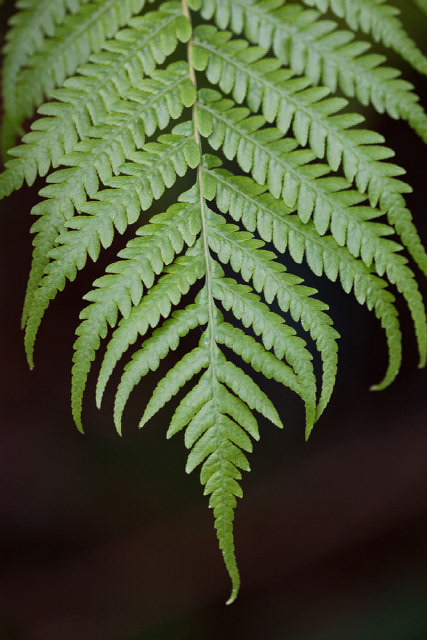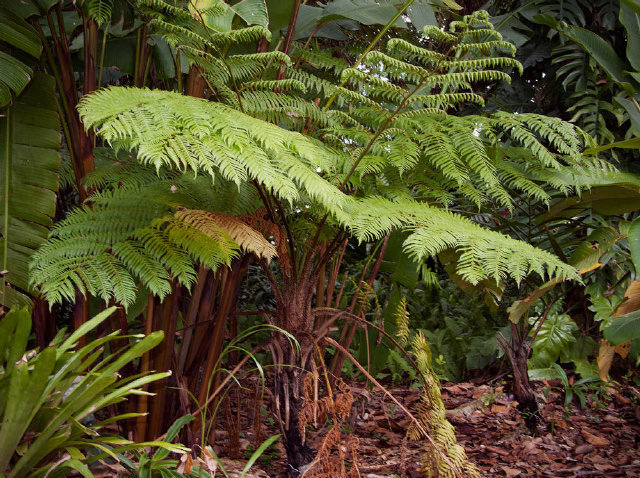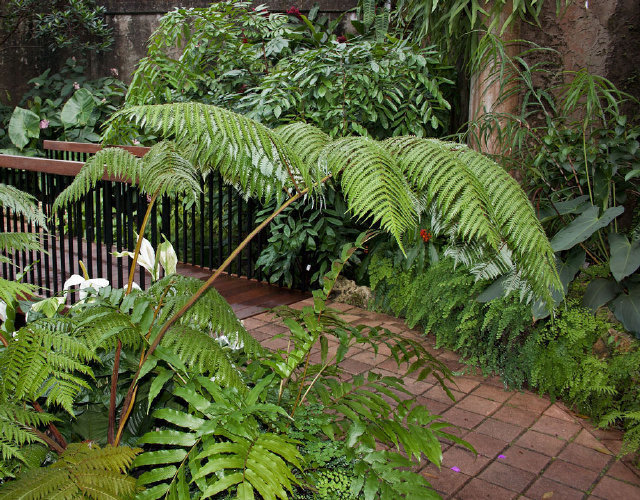Tree ferns bring tropical Australia to your garden

As published in The Miami Herald
Tree ferns look just like their names describe — tree-sized ferns, with a caudex, or trunk. They’re so iconically tropical in appearance, you can’t help but feel like you’re in a Hawaiian rainforest when standing in their presence. You might also expect to see a dinosaur devouring the delicate fronds, since ferns in general look “primitive,” and an arborescent example would certainly attract a large herbivorous reptile.
The Australian tree fern (Cyathea cooperi) is the most popular tree fern grown in the country and the one you are most likely to find for sale in a nursery. In Hawaii they are unfortunately outcompeting the native Hapu’u tree fern ( Cibotium glaucum), among others, and are considered invasive there, but are not considered a threat in the rest of the United States.
 |
| Australian tree fern frond. |
Tree ferns are perfect for what may be your more difficult garden areas because they prefer shady, sheltered and moist locations. Many of the direct-sun-loving plants we grow in South Florida won’t tolerate such conditions for long. The soil should drain well and not remain saturated or soggy for too long after watering (few plants like “wet feet”). Under the canopy of large trees where dappled shade can maintain soil moisture might be an ideal location. South Florida generally offers a suitable environment, as the Australian tree fern doesn’t like cold or drying winds. It should be especially content in our area, USDA Zone 10b.
Plant your fern as deep as it was in its container. Tree ferns are sometimes sold as sections of trunks with all fronds removed. If you buy one in this state, plant the trunk in only as much soil as necessary to stabilize it. Frondless trunks need to be watered daily until foliage appears.
Tree ferns do like neutral to acidic humus-rich soil, so our alkaline rocky gardens might need supplementing, preferably with compost. To encourage root growth, avoid fertilizing your fern during its first year; thereafter, spray an all-purpose dilute fertilizer over the fronds and trunk once a month during spring and summer, or just spread controlled-release fertilizer around the base at the beginning of spring. It’s a good idea to leave the soil around the base of the fern covered with some decomposing leaf litter; this helps maintain moisture, nourish the soil and provide habitat for many animals that live in decaying leaves and foliage.
 |
| Australian tree fern at Fairchild Tropical Botanic Garden. |
How much and often you’ll need to water depends on factors like the type of soil you have, time of year, location of your fern, and its size. Breezy, hot and sunny days can endanger your fern. It’s an understory plant and thrives on constant humidity. Until your fern becomes established, water it enough so that it never completely dries out, which may mean daily if you plant in the dry months or if summer isn’t producing as much rain as needed. Keep in mind to also water the crown, fronds and trunk. Remember, they require shade.
Don’t worry if some of your tree fern’s soft and lacey fronds eventually turn brown. This is similar to a palm frond turning yellow, then brown and ultimately falling off — it’s natural. Try to leave these senescent fronds on your fern, as the plant can translocate nutrients from them until they are completely brown and dry. If on the other hand young fronds — especially the fiddleheads emerging from the top center crown — are turning brown prematurely, this may be a sign of desiccation and you may need to increase watering or change the plant’s location.
 |
| Caribbean tree fern in the Windows to the Tropics Conservatory. |
If you want to see in person just how beautiful tree ferns are, Fairchild Tropical Botanic Garden has many on display, including the Australian tree fern ( Cyathea cooperi), Hawaiian tree fern (Cibotium glaucom), Mexican tree fern (C. schiedei), Caribbean tree fern (Cyathea arborea) and the rare native Florida tree fern (Ctenitis sloanei).
Australian tree ferns can grow to about 20 to 30 feet tall and 10 to15 feet wide. Trunks can grow to about one foot in diameter. They are usually inexpensive, so if you have the proper space, try growing one of these lacy, languid plants to show off the tropical profusion and fecundity we are fortunate to enjoy in South Florida.
